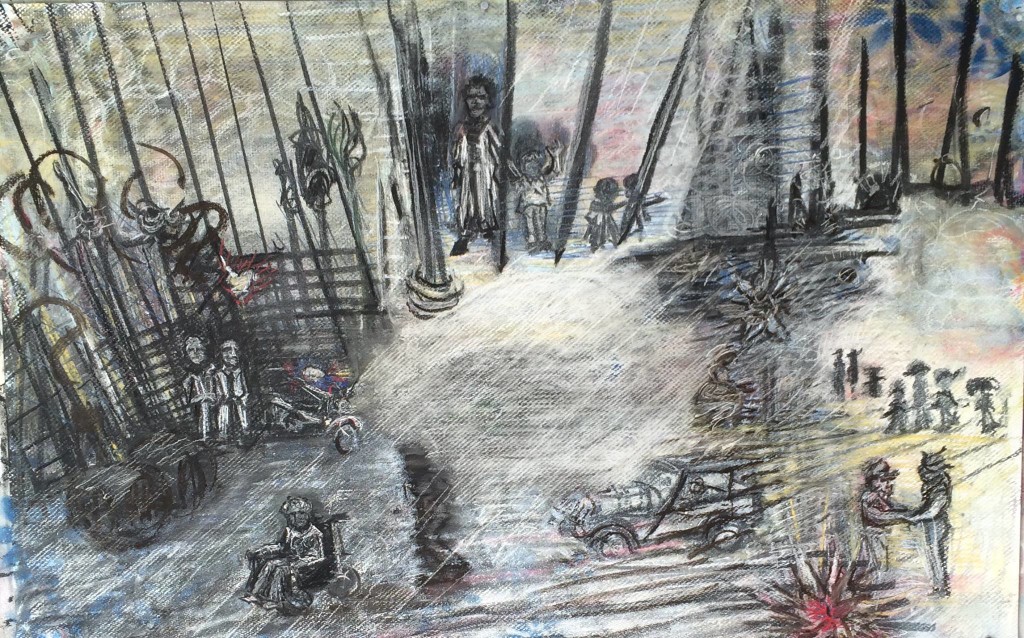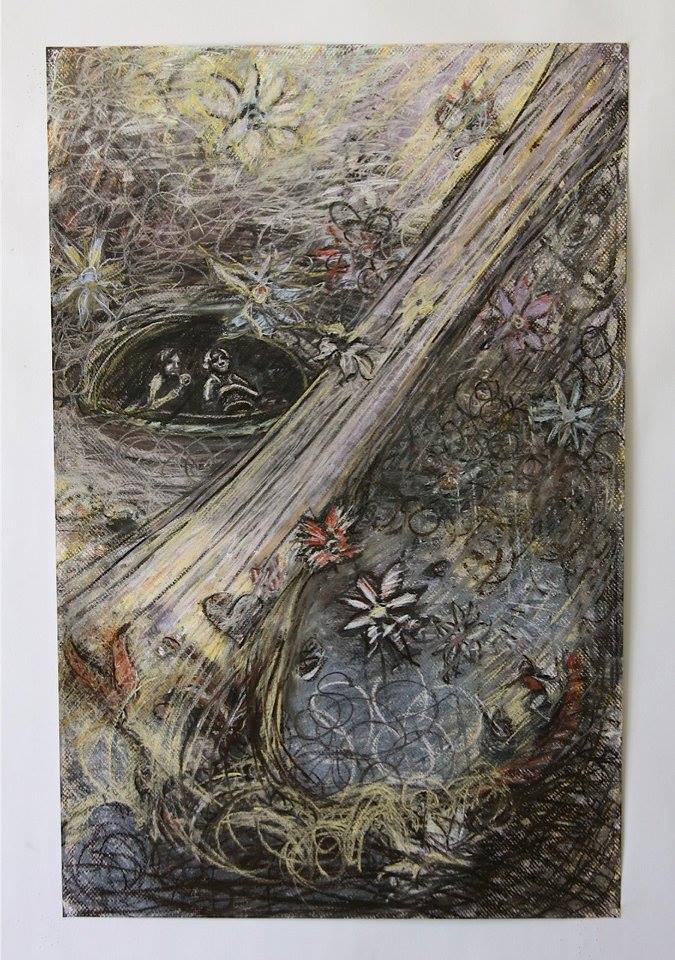The art of Randi Matushevitz is magical. It has the quality of a fairy or folktale; a narrative brave, loving, and a little bit spooky. There are symbols and signs, figures and landscapes – the impact of viewing her work is immersive and emotional. Enter the world of Matushevitz and become transformed. This is an alternative universe, like our own but unlike it, both delicate and intense.
“My process swings from intuitive to formal and back again. I draw. The work develops over days and weeks or more. I layer. I draw. I spray. I look and repeat.” In short, Matushevitz, working in pastels, deep charcoal, and acrylics, creates works as physically layered as they are emotionally dense.
In her “Bad Habits By The Pool,” she works in charcoal, pastel, and paint on paper to depict what appear to be two small nymph like creatures – or children – watching a woman smoking a cigarette by the pool. The pool is dark and dense, inky. The smaller figures stare, and near them is a box, which could be Pandora’s, perhaps. The yellow background and the pink of the woman’s skin are both the colors of dreams.
Throughout her recent series, “Mysterious,” the artist uses symbols and figures drawn and stenciled. “I provide the innuendo of space, intentional references and implied mood or location,” she says.
In “Liberty or Death” burnt sienna patterns dot a piece that also includes the outline of the Statue of Liberty’s crown. A bed, a bus, pipes, hearts, flowers – there is a wildness and an energy, a garden of technology, an infusion of love into our often harsh world. Are those bombs exploding? Fireworks “bursting in air?” Are the hearts floating in space simply symbolic hearts or are they living creatures infused with the ability to create love where none previously exists?
Matushevitz is less interested in explanations than she is in emotion. She says she includes “the power of color, texture, and pattern” to create the perception of love. “What we see has influence over how we perceive, interpret, and absorb information and thus determines what we think and who we become.”
The artist’s work is based on the idea that what we see has a deep effect on human perception and feeling – and what affects the individual also affects a larger society. She’s exploring all sides of the idea of love and the artifacts of human emotion, using tools of harmonious and disharmonious color, and her own unique combinations of symbols, colors, and patterns.
“I use memory, sentimentality and childlike whimsy to create images that are embellished and decorated to reveal kindness, respect and accountability,” Matushevitz says. “It’s a multi-sensory message that has been metaphysically explored since the beginning of time.”
In short, she believes we are what we think. While earlier works by the artist reflected a brighter tone and more whimsical nature, her more recent series plays with the idea of perception in an edgier tone.
In “Elephant in the Room,” for example, symbolic depictions of elephants are scattered across the page, a car, a butterfly, a fireplace, and over that fireplace, a painting or a mirror or a window reflects more cars. Is the elephant a metaphor for our lumbering vehicles, creating environmental chaos?
“It is a fight for the sanity of our culture as we know it,” the artist says, “we neglect and take for granted what is so important that it is discounted as if disposable. As if it is something that will always be there, until it is not.”
There is much to see and absorb in Matushevitz’s work. Like life itself, her works dance on an edge between belief and perception, light and dark. We are creations of our own dreams, she seems to be saying. But can we dream better?
In “Movie Time,” the answer appears to be affirmative, as two children watch a stream of flowers, and a small, fairy-like figure surfs a tangle of water-like roots on a seed pod. The niche in which the children are positioned is in the shape of an eye. Is this all an image taken from the mind’s eye, a moving picture of life?
Perhaps her “Self-Portrait” holds the answer. This piece is nearly monochromatic, touches of red like fire in her eyes, touches of green like growing things in the foreground. Her hair is wild, what could be fairies, trolls, or dybbuks wait on either shoulder. But her eyes are calm and kind, her lips pressed into a half-smile. Matushevitz seems to be saying what we accept, what we cannot know, what we see, what is unseen – it should all be approached with equanimity.
Whatever the world holds, in its mystery, in its magic, in its folklore and fairytales, the artist believes we need to give expression to that vision.
Matushevitz’s works have been shown both nationally and internationally in New York, LA, Las Vegas, Miami, Buenos Aires, Caracas, Madrid, and Xalapa. Her most recent exhibition was held in March on the UCLA campus.










BEAUTIFUL and unique, sentimental, combining soft/harsh like life can sometimes be depending on how we perceive it. Her art offers everything to be seen and/or imagined…